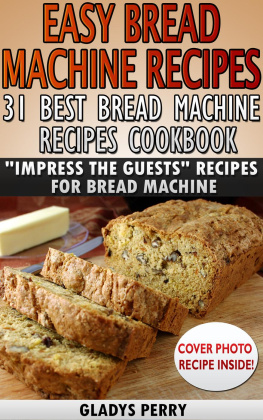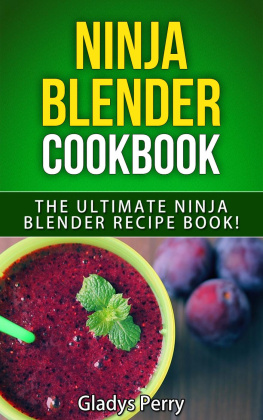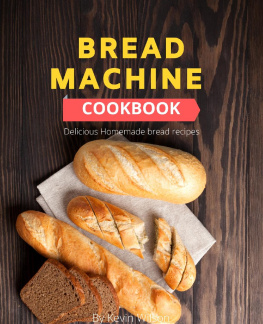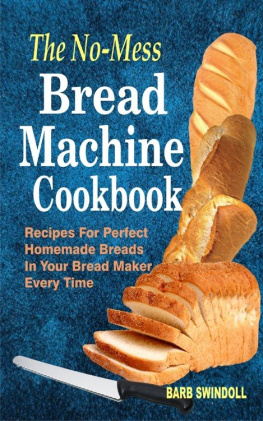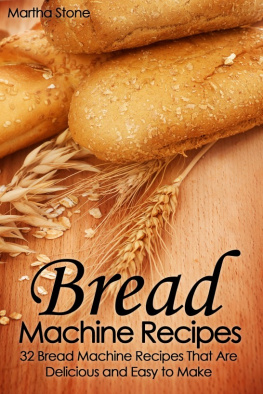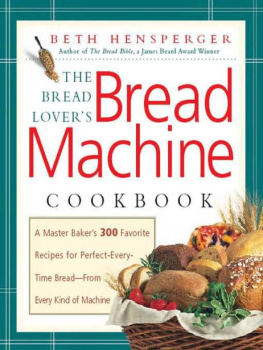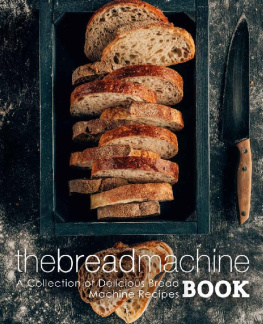Easy Bread Machine Recipes: 31+ Best Bread Machine Recipes Cookbook
"Impress the Guests" Recipes for Bread Machine
Contents
Copyright 2015
By reading this document, you assume all risks associated with using the advice given below, with a full understanding that you, solely, are responsible for anything that may occur as a result of putting this information into action in any way, and regardless of your interpretation of the advice
Introduction
W elcome to the beginning of your journey of a thousand breads. And with a dependable bread machine at home, you will no longer have to knead hard, roll-up your sleeves, and skip the clouds of flour. All you have to do is measure the ingredients into your bread pan according to the manufacturers instruction, press a button and wait for the perfect loaf. You wont even have to do a lot of clean-up! Afterwards, you will only have to wash a bread pan and a tiny blade.
But the best part about owning a bread machine is that I can set the bread machine to bake the familys favorite dinner roll before going to church, doing the laundry, playing with the kids, or just taking a quick rest. Two to three hours after taking care of family business, the dough is ready to be made into any form.
If I need bread ready for breakfast, the timer in my machine allows me to plan it ahead. If I want to bake a specialty bread, the 20 or so minutes that I would need kneading the dough by hands will be cut into as little as 5 minutes with less fuss and less mess. I only need to wait for the machine to finish mixing my dough.
Last, and the most important, I have the total control over the ingredients that I use in my bread baking. Homemade breads are definitely the best!
So what are you waiting for? If you havent made use of all the advantages your bread machine has to offer you, then now is your chance to start your own bread journey with these recipes that are bread machine and taste tested by my whole family, our friends, neighbors, and relatives.
Chapter 1 - The Perfect Loaf
I t does not matter how expensive your bread machine is or how great of a cook you are. The secret to baking the perfect loaf will always depend on the ingredients that you are using. In fact, it can be said that the golden rule for any cooking is to choose the freshest ingredients. So if you want your bread to be delicious, follow the guideless below.
White Flours
F lours with higher gluten content will produce higher bread loaf and brands with gold medal are the better bread flours. The texture will be coarser so white flour should only be used in recipes where it is indicated.
Most loaves rise too high with bread flour, which is why recommended to use bleached or unbleached all-purpose flour. Both flours are refined. The difference only being that bleached flour has been whitened with an oxidizing or bleach.
Whole-Grain Flours
F or hearty bread, using the right whole-grain will also affect the texture, taste, and the rise of your loaf.
Whole-Wheat Flour
T his flour is ground from the complete wheat berry and contains both the wheat germ and wheat bran. For bread baking in your machine, it is best NOT to use the stone ground whole wheat since it does not rise well in the machine and is coarser than the regular kind.
Rye Flour
M illed from rye grain, this flour is heavy, low in gluten, and rye dough is stickier than any other dough. You need to combine this flour with whole-wheat or white flour to create a good-sized loaf.
Barley Flour
M ade from barley kernels, this flour is rich in minerals a will create a slightly sweet, cakelike texture to the dough.
Buckwheat Flour
A little amount of this flour goes a long way and will give your loaf a grayish color with an earthy, strong, and tart flavor.
Millet Flour
G round whole millet will give your bread a dry crumbly texture and taste.
Oats
T hese have the highest mineral and protein content among all grains. They also create that rich country taste to bread that is both nutty and sweet.
Bulgur and Cracked Wheat
B oth are pieces of the whole wheat kernel. To distinguish simply, bulgur is cracked wheat that has been parboiled and dried to make cooking faster, and it will absorb liquid more quickly than cracked wheat.
Bran
T his is the outer covering of the wheat kernel and adds flavor, texture, and fiber to bread. Use with caution. Too much bran can hamper the growth of yeast. Do not use more than 1/3 cup for 1-pound small, 1/2 cup for 1 1/2-pound medium, and 2/3 cup for a 2-pound large loaf.
Wheat Germ
T his is the tiny embryo of the wheat kernel that adds a nutty flavor and texture to a whole-grain bread. Use with caution. Too much wheat germ can also hamper the growth of yeast. Do not use more than 1/4 cup for 1-pound small or1 1/2-pound medium and 1/2 cup for a 2-pound large loaf.
Millet
R esembling a mustard seed, this round grain has a yellowish color. This will give your loaf extra nutrition and a crunchy texture.
TIPS:
- Whole-grain bread will have a robust flavor and will brown faster. If they come out too dark, you can set to Light Crust when baking.
- Wheat germ and whole-grain flours contain natural oils that go rancid fast if you store them at room temperature. Make sure to store them inside airtight containers and put them in the refrigerator or the freezer.
- Whole-grain flours are readily available at local natural-food stores and the large stores offer them in open bins or packaged. Compare prices. In my experience, buying them in bulk from bins is a better deal.
- Only wheat, white, and rye flour contain gluten. So when baking wholegrain bread, you will need a base of white and/or whole-wheat flour. Most bread machines are adjusted to allow longer rising period for the whole-wheat cycle since these grains do not rise quickly.
Vital Wheat Gluten
T his additive is almost pure gluten that will give your bread increased height and extra strength. You can use this to boost your heavy whole-grain bread. The recommended amount is 1 tbsp. per 1 cup of flour. Gluten flour is not vital wheat gluten for the sole reason that the latter is not flour but the pure gluten that remains when you wash starch, dry, grind, and pack it.
Liquids
T he right amount of liquid is vital for the proper consistency of the dough, which should be pliable, smooth, and slightly tacky to the touch after 5-10 minutes of kneading.
Water
T he ideal water for making the bread dough is bottled spring water because it contains all the minerals the yeast needs to grow and has no chlorine. Using water with high sodium content, such as softened water, is not advised.
Buttermilk
F resh is always best. But you can buy a small carton and store it in a freezer. It will last for up to a month once you defrost it. Make sure to shake it well before using.
I have discovered that storing canned powdered milk is more convenient. Whenever I need buttermilk in my recipe, I just substitute every 1/4 cup of buttermilk with the same amount of water and add 1 tbsp. of powdered buttermilk to the list of dry ingredients. The ratio is 1 tbsp. powdered buttermilk for every 1/4 cup buttermilk, plus water.
Fresh Milk
Y ou can substitute 3/4 - 1 tbsp. non-fat dry milk powder to the dry ingredients for every 1/4 cup of fresh milk needed for the recipe.
Fats
T hey not only keep the bread from turning stale quickly, fats also add tenderness and flavor.
Next page
